Different coloured stool. Decoding Stool Colors: What Different Shades Reveal About Your Health
What do various stool colors indicate about your digestive health. How can diet affect the color of your poop. When should you be concerned about changes in stool color.
The Rainbow of Stool Colors: Understanding Normal and Abnormal Shades
The color of your stool can provide valuable insights into your digestive health and overall well-being. While changes in stool color are often harmless and related to diet, certain hues may signal underlying health issues that require medical attention. Let’s explore the spectrum of stool colors and what they might mean for your health.
What determines the color of your stool?
The primary factor influencing stool color is bile, a yellowish-green fluid produced by the liver to aid in fat digestion. As bile pigments travel through the digestive system, they undergo chemical changes, resulting in the typical brown color of healthy stool. However, various factors can alter this hue, including:

- Diet and food choices
- Medications and supplements
- Digestive conditions
- Liver or gallbladder issues
- Bleeding within the digestive tract
Brown Stool: The Hallmark of Healthy Digestion
Brown is the most common and typically healthiest color for stool. This shade indicates that your digestive system is functioning properly, with bile effectively breaking down fats and waste products moving through your intestines at an appropriate pace.
Why is brown stool considered normal?
Brown stool is a sign that your liver is producing adequate bile, your gallbladder is releasing it effectively, and your intestines are absorbing nutrients and eliminating waste as they should. The brown color results from the breakdown of bilirubin, a byproduct of red blood cell destruction, which is processed by the liver and excreted in bile.
Green Stool: From Diet to Digestive Speed
Green stool can be alarming, but it’s often harmless and may even be considered normal for some individuals. There are several reasons why your stool might take on a green hue.

What causes green stool?
Green stool can result from:
- Consuming chlorophyll-rich foods like spinach or kale
- Ingesting food coloring in drinks or treats
- Taking iron supplements
- Experiencing rapid intestinal transit, which prevents bile from breaking down completely
In most cases, green stool is not a cause for concern. However, if it persists or is accompanied by other symptoms, it’s wise to consult a healthcare professional.
Yellow Stool: Potential Signs of Malabsorption
Yellow stool can range from a pale, clay-like color to a more vibrant yellow shade. While sometimes normal, particularly in breastfed infants, yellow stool in adults may indicate digestive issues.
Is yellow stool always a cause for concern?
Not necessarily. However, if your stool is consistently yellow, greasy, and foul-smelling, it could signify excess fat content, potentially due to malabsorption issues. This might be related to conditions such as:
- Celiac disease
- Pancreatic insufficiency
- Gallbladder problems
- Liver disorders
If you frequently notice yellow, greasy stools, it’s advisable to seek medical advice to rule out underlying health concerns.

White or Clay-Colored Stool: A Potential Red Flag
Pale or clay-colored stools are often a cause for concern, as they may indicate a lack of bile in the stool. This can be a sign of serious liver or gallbladder issues.
What health conditions can cause white or clay-colored stool?
Several conditions can lead to pale or clay-colored stools:
- Hepatitis or other liver diseases
- Gallstones or biliary tract obstruction
- Pancreatic cancer
- Biliary atresia in newborns
It’s important to note that certain medications, such as bismuth subsalicylate (Pepto-Bismol), can temporarily cause light-colored stools. If pale stools persist without a clear cause, prompt medical evaluation is crucial.
Black Stool: Between Dietary Influences and Digestive Bleeding
Black stool can be alarming, but it’s not always a sign of a serious problem. Understanding the potential causes can help you determine whether medical attention is necessary.
Can certain foods cause black stool?
Yes, some foods and supplements can turn your stool black, including:

- Black licorice
- Blueberries
- Iron supplements
- Bismuth subsalicylate-containing medications
However, if your stool appears tarry and you haven’t consumed these items, it could indicate bleeding in the upper gastrointestinal tract. This requires immediate medical attention, as it may be caused by ulcers, esophageal tears, or even tumors.
Red or Reddish Stool: Dietary Effects vs. Lower GI Bleeding
Red or reddish stool can be startling, but it’s not always a sign of a medical emergency. The key is to determine whether the color is due to diet or potential bleeding.
What foods can cause red stool?
Several foods and beverages can impart a red or pinkish hue to your stool:
- Beets
- Tomato-based products
- Red gelatin desserts
- Foods with red food coloring
If you’ve recently consumed these items, red stool is likely harmless. However, if the red color persists or is accompanied by pain, fever, or other concerning symptoms, it could indicate lower gastrointestinal bleeding from conditions such as hemorrhoids, anal fissures, or inflammatory bowel disease.

Orange Stool: Balancing Diet and Digestive Health
Orange stool is less common but can occur due to both dietary and health-related factors. Understanding the potential causes can help you determine whether further investigation is needed.
What causes orange stool?
Orange stool may result from:
- Consuming foods high in beta-carotene, such as carrots and sweet potatoes
- Eating foods with orange food coloring
- Taking certain medications or supplements
- Bile duct obstruction or liver issues
In most cases, orange stool is temporary and harmless. However, if it persists or is accompanied by other symptoms like abdominal pain or weight loss, consult a healthcare provider to rule out underlying health concerns.
How can you differentiate between diet-related and health-related orange stool?
To determine if your orange stool is diet-related or potentially indicative of a health issue, consider the following:
- Review your recent diet and any new medications or supplements
- Monitor the duration of the color change
- Note any accompanying symptoms
- Observe the consistency and frequency of your bowel movements
If the orange color persists for more than a few days or is accompanied by other digestive symptoms, it’s best to consult a healthcare professional for further evaluation.

When to Seek Medical Attention for Stool Color Changes
While many stool color changes are harmless and temporary, certain situations warrant prompt medical attention. Being aware of these red flags can help you make informed decisions about your digestive health.
What stool color changes require immediate medical evaluation?
Seek medical care if you experience:
- Black, tarry stools not explained by diet or medication
- Bright red blood in the stool
- Persistent white or clay-colored stools
- Persistent yellow, greasy stools accompanied by foul odor
- Any unusual stool color lasting more than a few days
Additionally, if stool color changes are accompanied by symptoms such as severe abdominal pain, fever, unexplained weight loss, or changes in bowel habits, it’s crucial to consult a healthcare provider promptly.
How do doctors evaluate unusual stool colors?
When investigating unusual stool colors, healthcare providers may:
- Take a detailed medical history, including recent diet and medication use
- Perform a physical examination
- Order stool tests to check for blood, fat content, or infections
- Recommend imaging studies such as CT scans or endoscopies
- Conduct blood tests to assess liver and pancreatic function
These evaluations help determine the underlying cause of stool color changes and guide appropriate treatment if necessary.

Maintaining Healthy Digestion: Tips for Optimal Stool Health
While occasional changes in stool color are normal, maintaining overall digestive health can help ensure consistent, healthy bowel movements. Implementing certain lifestyle habits can support optimal stool health and digestive function.
How can you promote healthy digestion and regular bowel movements?
To support digestive health and maintain normal stool color and consistency:
- Stay hydrated by drinking plenty of water throughout the day
- Consume a balanced diet rich in fiber from fruits, vegetables, and whole grains
- Exercise regularly to promote intestinal motility
- Manage stress through relaxation techniques or mindfulness practices
- Avoid excessive alcohol consumption and smoking
- Listen to your body and maintain a consistent bathroom routine
By incorporating these habits into your daily life, you can support healthy digestion and reduce the likelihood of experiencing unusual stool colors or digestive issues.
Are there any supplements that can promote digestive health?
While a balanced diet should provide most necessary nutrients, some supplements may support digestive health:
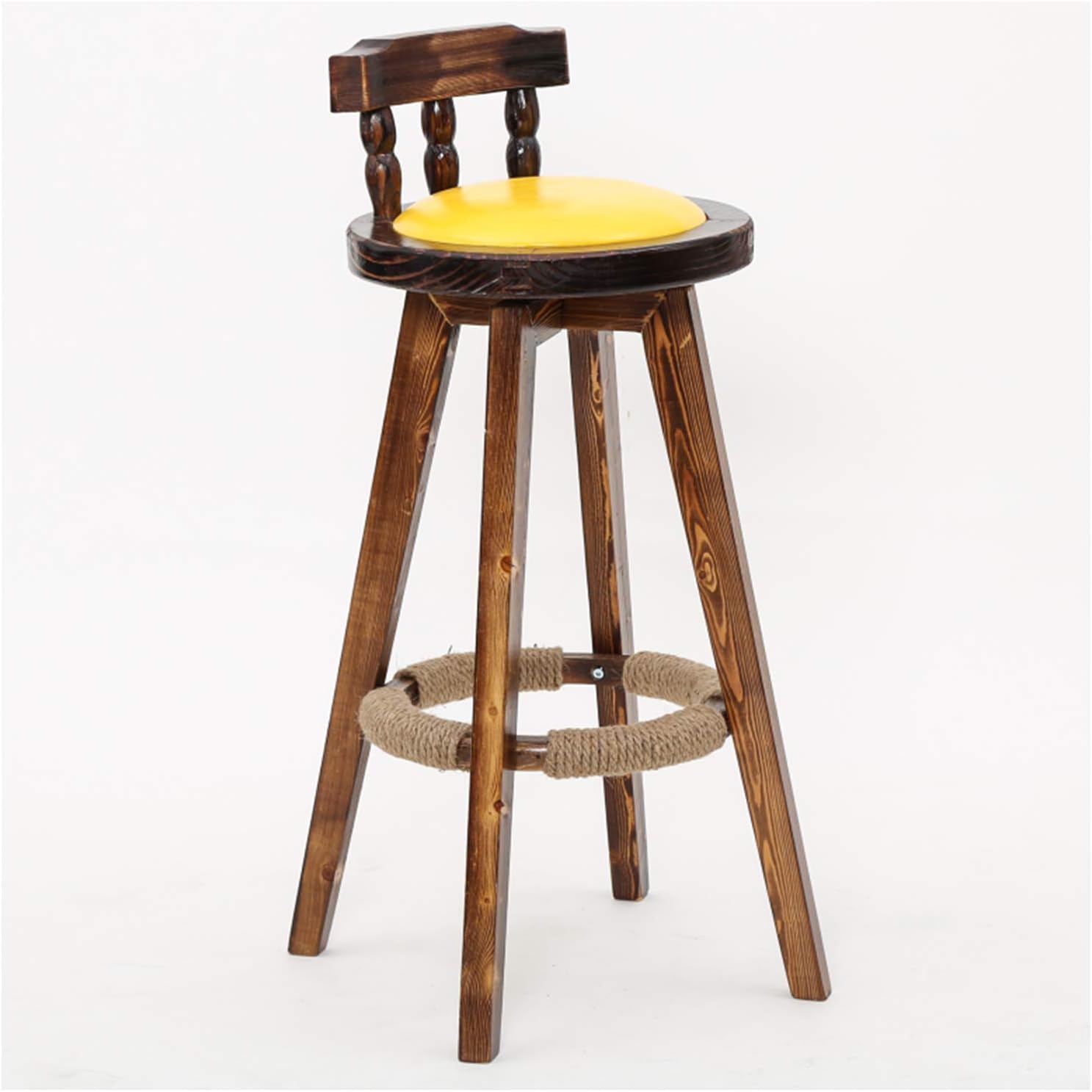
- Probiotics to promote a healthy gut microbiome
- Digestive enzymes to aid in nutrient absorption
- Fiber supplements for those struggling to get enough through diet alone
- Omega-3 fatty acids to reduce inflammation in the digestive tract
Always consult with a healthcare provider before starting any new supplement regimen, as individual needs may vary based on health status and existing conditions.
The Bottom Line: Understanding Your Stool’s Story
Paying attention to your stool color can provide valuable insights into your digestive health and overall well-being. While many color variations are harmless and diet-related, persistent changes or those accompanied by other symptoms should not be ignored. By staying informed about what different stool colors may indicate and maintaining healthy digestive habits, you can take proactive steps to support your gastrointestinal health and catch potential issues early.
How often should you monitor your stool color?
While it’s not necessary to obsessively check your stool color daily, being generally aware of your bowel habits is beneficial. Make it a habit to glance at your stool before flushing, noting any significant or persistent changes. This simple practice can help you detect potential health issues early and maintain a proactive approach to your digestive wellness.
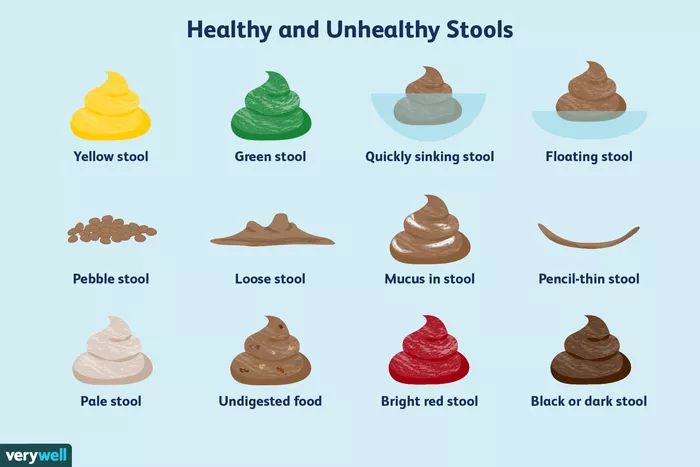
Remember, your stool is a window into your body’s inner workings. By understanding what different colors may signify and when to seek medical advice, you empower yourself to make informed decisions about your health. If you ever have concerns about your stool color or consistency, don’t hesitate to discuss them with a healthcare professional. Your digestive health is an essential component of your overall well-being, and staying attuned to your body’s signals can lead to a healthier, happier you.
What Do Different Poop Colors Mean?
Written by Hope Cristol
- What Do Different Stool Colors Mean?
- Normal Poop Color
- Green Poop
- Yellow Poop
- White, Pale, or Clay-Colored Poop
- Black Poop
- Red or Reddish Poop
- Orange Poop
- When to Get Help for Poop Color Changes
- More
Different stool colors can mean different things, mostly depending on what you’ve eaten.
You’d probably notice if your poop is a different hue than normal. But what does it mean if it’s green? What about red, yellow, white, or black? Or orange?
Most of the time, minor changes in the color of your waste are due to diet. After all, we don’t eat the same thing at every meal, every day. But sometimes a color change can signal a minor health issue. In rare cases, it means something serious is wrong in your digestive system.
If the color you see before you flush worries you, call your doctor.
Poop is normally brown. The color is the result of what you eat and how much bile is in your stool.
The color is the result of what you eat and how much bile is in your stool.
Bile is a fluid your liver makes to digest fats. It starts out as a yellowish green color. But as the pigments that give bile its color travel through your digestive system, they go through chemical changes and turn brown.
Your poop can sometimes have a slightly greenish hue, or even be a more vivid green. Most of the time, green or greenish poop is normal.
Is your diet causing green poop?
Think back on what you’ve been eating. These foods and supplements can cause your poop to be green:
- Green veggies, like spinach or kale
- Green food coloring, such as in drink mixes or ice pops
- Iron supplements
Other causes of green poop
If you have green diarrhea, the color of your food may not be to blame. It’s likely that your meal moved through your gut too quickly, so the fat-digesting bile didn’t have time to turn brown.
There may be times when your poop looks more yellow than brown.
This shade is also normal for many people. It’s common for babies, especially those who breastfeed. But if you have yellow poop that looks greasy and smells very bad, it may have too much fat. That could be a sign your body isn’t digesting food properly.
Is your diet causing yellow poop?
Indirectly, your diet could cause yellow poop. If you have celiac disease, your body can’t handle a protein called gluten, which is in wheat, barley, and rye. If you have the condition and eat foods that have gluten, like many breads, pastas, and cookies, your intestines won’t work as they should. So, if you’re eating those foods, and your poop is yellow, it may be time to see a doctor.
Other causes of yellow poop
There may be other causes of yellow poop that’s greasy and smelly. If it happens to you often, tell your doctor.
Sometimes, poop may not have much color at all.
Is your diet causing pale poop?
If your poop is pale, it’s not likely directly due to a food. But medicines for diarrhea like bismuth subsalicylate (Kaopectate, Pepto-Bismol) can sometimes cause pale or clay-colored poop. So can barium, a chalky liquid you drink before you get X-rays of the upper part of your digestive tract.
Other causes of pale poop
A more serious cause is a lack of bile in your stool. (Remember, bile gives poop its brown color.) Your body makes bile in the liver, stores it in the gallbladder, and releases it into your small intestine to help digest your food. If there’s not enough of it to give your poop its typical brown color, it could be a sign of a problem along the way.
Liver disease, such as hepatitis, can keep bile from getting into your body waste. So can a blockage in the tubes (called ducts) that carry bile. This can happen because of:
- Gallstones
- A tumor
- A condition you’re born with called biliary atresia
Babies’ poop is black for the first few days after they’re born. Otherwise, it may be because you ate something very dark-colored or took a medicine or supplement that causes black poop. But this color can be a sign of a more serious problem: bleeding in the upper part of your digestive tract.
Otherwise, it may be because you ate something very dark-colored or took a medicine or supplement that causes black poop. But this color can be a sign of a more serious problem: bleeding in the upper part of your digestive tract.
Is your diet causing black poop?
Foods and supplements that turn poop black include:
- Black licorice
- Blueberries
- Iron supplements
Medicines that have bismuth subsalicylate (Kaopectate, Pepto-Bismol) can also cause very dark stools.
Other causes of black poop
Poop that looks like tar is often a sign of bleeding in the digestive tract. Some causes include:
- Bleeding from stomach ulcers
- Bleeding sores in your esophagus from acid reflux
- Bleeding from noncancerous tumors in the upper GI tract
- Cancer
If you don’t think black poop came from what you ate, you need to talk to your doctor.
If you see red or reddish poop in the toilet, don’t be alarmed right away. First ask yourself if you’ve had red foods lately.
First ask yourself if you’ve had red foods lately.
Is your diet causing red or reddish poop?
Several foods can change the color of your stool to a pink or reddish color:
- Beets
- Tomato soup
- Gelatin dessert
- Red drinks
Other causes of red or reddish poop
If you don’t think your diet is the cause, the red you see may be blood. And if it’s bright red, the blood likely comes from the lower part of your digestive tract. Common causes include:
- Noncancerous tumors
- Cancer
- Inflammation in the colon, called colitis
- Growths called polyps in your colon
- Conditions caused by small sacs in the wall of the colon, called diverticular disease
- Hemorrhoids
Call your doctor if you see red that’s probably not from food you ate.
Poop can often come out the color of the food that went in, especially if you have diarrhea. If your poop has an orange hue, it’s most likely due to some orange foods.
Is your diet causing orange poop?
Foods that have beta-carotene can turn your poop orange, such as:
- Carrots
- Winter squash
- Pumpkin
- Sweet potatoes
Foods with orange coloring, such as sodas, candy, or gelatin dessert, can also give your poop an orange color.
Also, antibiotics and antacids that have aluminum hydroxide in them can make your stool orange.
Other causes of orange poop
Rarely, poop can be orange if you have a problem with your liver that causes it to make less bile than normal, or a blockage that keeps bile from leaving the liver and entering your system. But usually, if this is the case, your poop will be pale or clay-colored.
Most of the time, poop that’s a different color from what you’re used to isn’t something to worry about. It’s rare for it to be a sign of a serious condition in your digestive system. But if it’s white, bright red, or black, and you don’t think it’s from something you ate, call your doctor.
Top Picks
What Do Different Poop Colors Mean?
Written by Hope Cristol
- What Do Different Stool Colors Mean?
- Normal Poop Color
- Green Poop
- Yellow Poop
- White, Pale, or Clay-Colored Poop
- Black Poop
- Red or Reddish Poop
- Orange Poop
- When to Get Help for Poop Color Changes
- More
Different stool colors can mean different things, mostly depending on what you’ve eaten.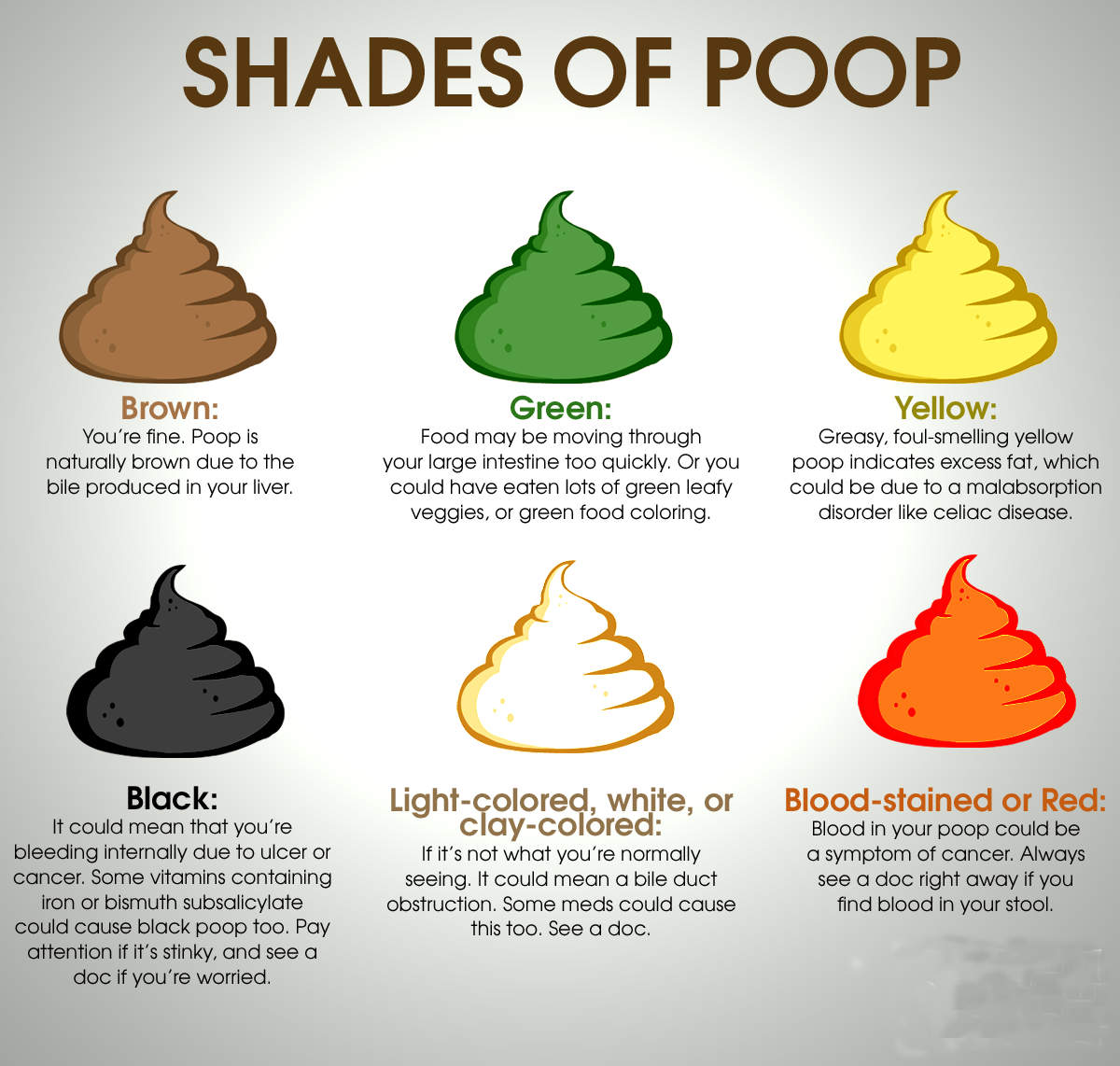
You’d probably notice if your poop is a different hue than normal. But what does it mean if it’s green? What about red, yellow, white, or black? Or orange?
Most of the time, minor changes in the color of your waste are due to diet. After all, we don’t eat the same thing at every meal, every day. But sometimes a color change can signal a minor health issue. In rare cases, it means something serious is wrong in your digestive system.
If the color you see before you flush worries you, call your doctor.
Poop is normally brown. The color is the result of what you eat and how much bile is in your stool.
Bile is a fluid your liver makes to digest fats. It starts out as a yellowish green color. But as the pigments that give bile its color travel through your digestive system, they go through chemical changes and turn brown.
Your poop can sometimes have a slightly greenish hue, or even be a more vivid green. Most of the time, green or greenish poop is normal.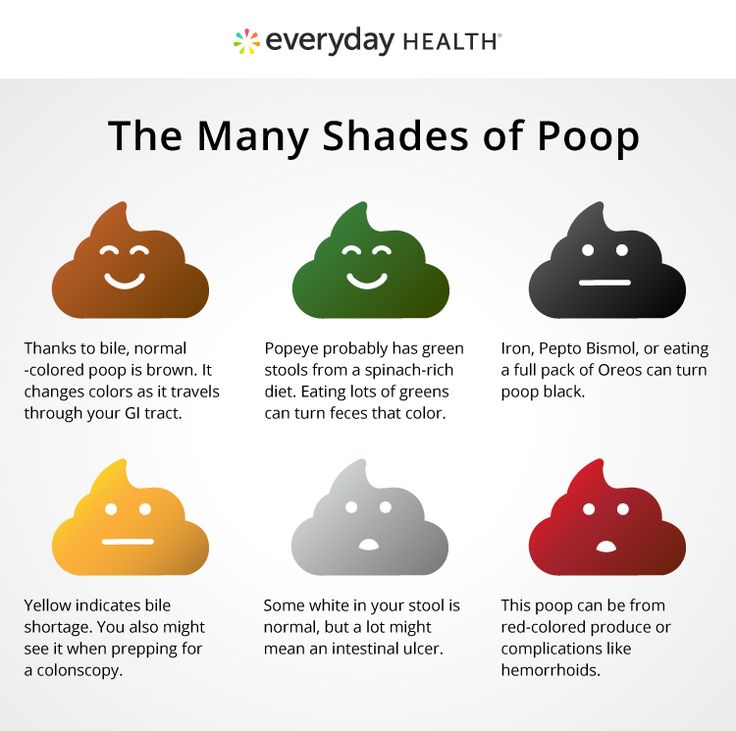
Is your diet causing green poop?
Think back on what you’ve been eating. These foods and supplements can cause your poop to be green:
- Green veggies, like spinach or kale
- Green food coloring, such as in drink mixes or ice pops
- Iron supplements
Other causes of green poop
If you have green diarrhea, the color of your food may not be to blame. It’s likely that your meal moved through your gut too quickly, so the fat-digesting bile didn’t have time to turn brown.
There may be times when your poop looks more yellow than brown.
This shade is also normal for many people. It’s common for babies, especially those who breastfeed. But if you have yellow poop that looks greasy and smells very bad, it may have too much fat. That could be a sign your body isn’t digesting food properly.
Is your diet causing yellow poop?
Indirectly, your diet could cause yellow poop. If you have celiac disease, your body can’t handle a protein called gluten, which is in wheat, barley, and rye. If you have the condition and eat foods that have gluten, like many breads, pastas, and cookies, your intestines won’t work as they should. So, if you’re eating those foods, and your poop is yellow, it may be time to see a doctor.
If you have the condition and eat foods that have gluten, like many breads, pastas, and cookies, your intestines won’t work as they should. So, if you’re eating those foods, and your poop is yellow, it may be time to see a doctor.
Other causes of yellow poop
There may be other causes of yellow poop that’s greasy and smelly. If it happens to you often, tell your doctor.
Sometimes, poop may not have much color at all.
Is your diet causing pale poop?
If your poop is pale, it’s not likely directly due to a food. But medicines for diarrhea like bismuth subsalicylate (Kaopectate, Pepto-Bismol) can sometimes cause pale or clay-colored poop. So can barium, a chalky liquid you drink before you get X-rays of the upper part of your digestive tract.
Other causes of pale poop
A more serious cause is a lack of bile in your stool. (Remember, bile gives poop its brown color.) Your body makes bile in the liver, stores it in the gallbladder, and releases it into your small intestine to help digest your food. If there’s not enough of it to give your poop its typical brown color, it could be a sign of a problem along the way.
If there’s not enough of it to give your poop its typical brown color, it could be a sign of a problem along the way.
Liver disease, such as hepatitis, can keep bile from getting into your body waste. So can a blockage in the tubes (called ducts) that carry bile. This can happen because of:
- Gallstones
- A tumor
- A condition you’re born with called biliary atresia
Babies’ poop is black for the first few days after they’re born. Otherwise, it may be because you ate something very dark-colored or took a medicine or supplement that causes black poop. But this color can be a sign of a more serious problem: bleeding in the upper part of your digestive tract.
Is your diet causing black poop?
Foods and supplements that turn poop black include:
- Black licorice
- Blueberries
- Iron supplements
Medicines that have bismuth subsalicylate (Kaopectate, Pepto-Bismol) can also cause very dark stools.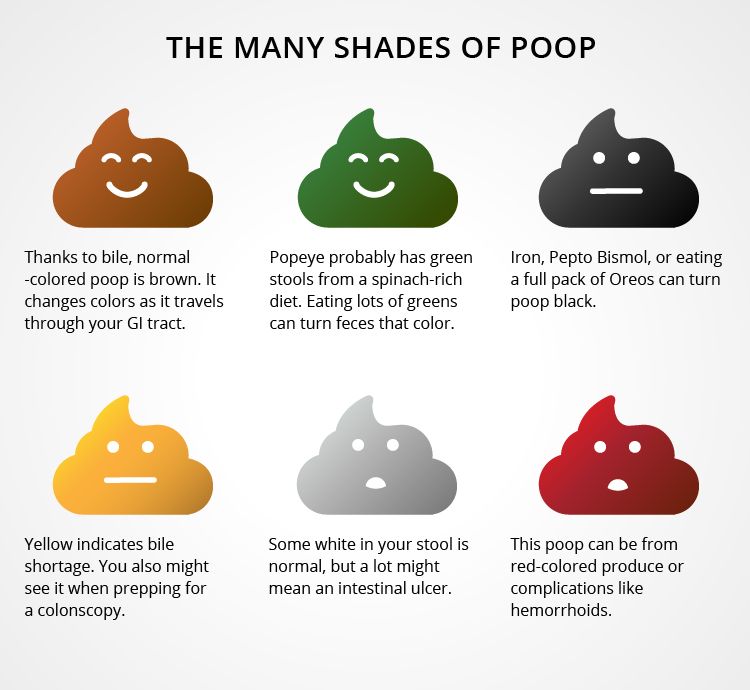
Other causes of black poop
Poop that looks like tar is often a sign of bleeding in the digestive tract. Some causes include:
- Bleeding from stomach ulcers
- Bleeding sores in your esophagus from acid reflux
- Bleeding from noncancerous tumors in the upper GI tract
- Cancer
If you don’t think black poop came from what you ate, you need to talk to your doctor.
If you see red or reddish poop in the toilet, don’t be alarmed right away. First ask yourself if you’ve had red foods lately.
Is your diet causing red or reddish poop?
Several foods can change the color of your stool to a pink or reddish color:
- Beets
- Tomato soup
- Gelatin dessert
- Red drinks
Other causes of red or reddish poop
If you don’t think your diet is the cause, the red you see may be blood. And if it’s bright red, the blood likely comes from the lower part of your digestive tract. Common causes include:
Common causes include:
- Noncancerous tumors
- Cancer
- Inflammation in the colon, called colitis
- Growths called polyps in your colon
- Conditions caused by small sacs in the wall of the colon, called diverticular disease
- Hemorrhoids
Call your doctor if you see red that’s probably not from food you ate.
Poop can often come out the color of the food that went in, especially if you have diarrhea. If your poop has an orange hue, it’s most likely due to some orange foods.
Is your diet causing orange poop?
Foods that have beta-carotene can turn your poop orange, such as:
- Carrots
- Winter squash
- Pumpkin
- Sweet potatoes
Foods with orange coloring, such as sodas, candy, or gelatin dessert, can also give your poop an orange color.
Also, antibiotics and antacids that have aluminum hydroxide in them can make your stool orange.
Other causes of orange poop
Rarely, poop can be orange if you have a problem with your liver that causes it to make less bile than normal, or a blockage that keeps bile from leaving the liver and entering your system. But usually, if this is the case, your poop will be pale or clay-colored.
But usually, if this is the case, your poop will be pale or clay-colored.
Most of the time, poop that’s a different color from what you’re used to isn’t something to worry about. It’s rare for it to be a sign of a serious condition in your digestive system. But if it’s white, bright red, or black, and you don’t think it’s from something you ate, call your doctor.
Top Picks
Red feces – causes, diagnosis and treatment
Red feces – this is the appearance of a reddish color of stools, which is often accompanied by pain and dyspeptic disorders. The symptom occurs with hemorrhoids, severe intestinal infections, inflammatory bowel disease and malignant tumors. To determine the cause of staining excrement in red, a coprogram, colonoscopy, and contrast radiography of the digestive tract are performed. To eliminate the identified pathology, antibiotics, anesthetics, and surgical methods of therapy are prescribed.
The symptom occurs with hemorrhoids, severe intestinal infections, inflammatory bowel disease and malignant tumors. To determine the cause of staining excrement in red, a coprogram, colonoscopy, and contrast radiography of the digestive tract are performed. To eliminate the identified pathology, antibiotics, anesthetics, and surgical methods of therapy are prescribed.
Causes of red stool
Use of coloring foods
Most often, the appearance of red stool in adults is associated with eating large quantities of foods of the corresponding color – beets, tomatoes, berries. The reddish tint of stool is caused by artificial dyes in the composition of candy, carbonated drinks. In this case, the stool has a normal consistency, the frequency of defecation does not change. There are no other discomforts from the gastrointestinal tract. Normalization of the color of feces occurs in 1-2 days.
Hemorrhoids
Blood from dilated hemorrhoids is excreted in drops already at the onset of the disease.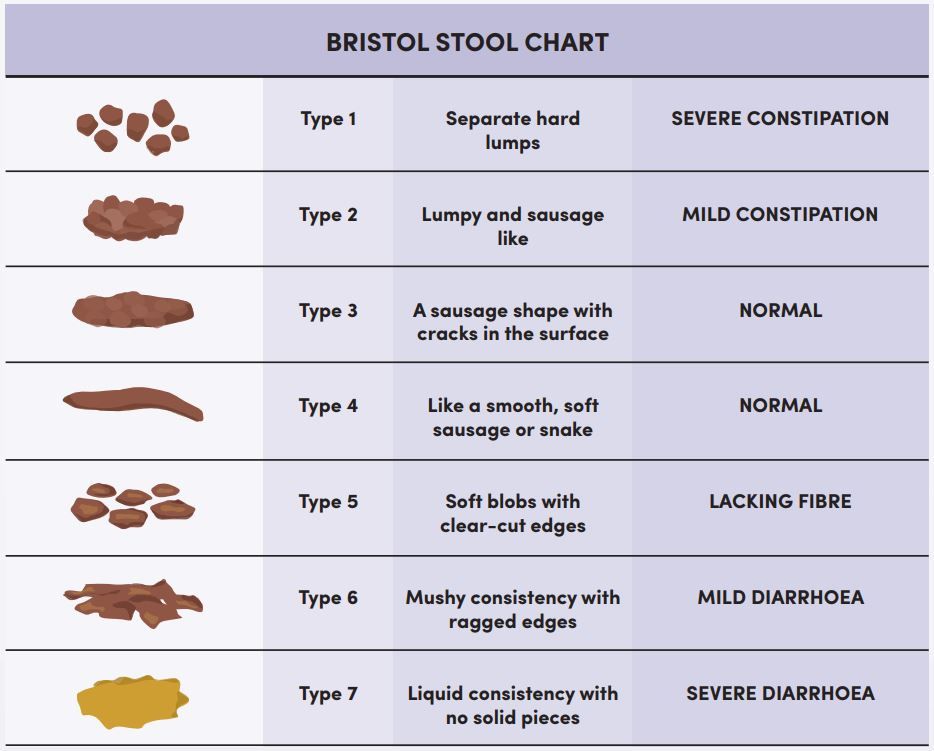 In this case, the feces have a normal color, but red streaks become noticeable on its surface. The frequency of stools with hemorrhoids is reduced to 3-4 times a week, which is due to reflex spasm of the muscles of the rectal sphincter. Characterized by pain in the anus, which sharply increases with defecation.
In this case, the feces have a normal color, but red streaks become noticeable on its surface. The frequency of stools with hemorrhoids is reduced to 3-4 times a week, which is due to reflex spasm of the muscles of the rectal sphincter. Characterized by pain in the anus, which sharply increases with defecation.
As the disease progresses and the venous nodes increase in size, hemorrhoidal bleeding becomes more frequent. The stool becomes greasy or liquid and reddish in color due to the large amount of blood. In severe situations, with ulceration of the hemorrhoidal veins, profuse bleeding begins, in which the stool loses its fecal character, bright red blood is released from the anus.
Other diseases of the rectum
The appearance of red inclusions in the stool is caused by inflammatory causes. In acute erosive proctitis, blood is released from the affected mucosa, which stains the stool. In the case of a bacterial infection, feces of a liquid consistency with abundant bloody-purulent inclusions are observed. Also, patients experience constant pain in the anal area with irradiation to the perineum and sacrum.
Also, patients experience constant pain in the anal area with irradiation to the perineum and sacrum.
Red stools provoke anal fissures. They are characterized by the occurrence of severe sharp pain during defecation, then stools appear mixed with blood. Symptoms often develop with prolonged constipation, when a person has to strain hard, and dry, hard feces injure the intestinal mucosa. The formation of an anal fissure is possible in women after childbirth.
Infections
Red streaks in stools are a characteristic symptom of dysentery (shigellosis). Bacterial toxins lead to damage to the intestinal walls, from which blood is excreted. At the beginning of the disease, the stool is liquid, has a fecal character with separate bloody inclusions. In severe cases, the number of bowel movements increases to 10-12 times a day, stools are scanty in the form of mucus mixed with blood. Patients complain of severe abdominal cramps, especially in the left sections.
Abundant red stools sometimes occur at 3-4 weeks in a typical course of typhoid fever, which is associated with bleeding from a deep typhoid ulcer. Liquid mucous stools with a lot of blood in the type of “raspberry jelly” is a pathognomonic sign of amoebiasis. In addition to the reddish color of feces, severe abdominal pain, nausea and vomiting are disturbing. With such symptoms, emergency medical care is indicated.
Inflammatory bowel disease
In Crohn’s disease and ulcerative colitis, deep ulcerative defects are formed that bleed. Red stool is more characteristic of UC because it causes damage to the distal intestine. Against the background of painful imperative urge to defecate, there is a release of scanty feces with impurities of scarlet blood. Exacerbations are provoked by such causes as stress, errors in diet, concomitant intestinal infections.
Neoplasms
Rarely, reddish coloration of stools is observed in colonic polyps and other benign tumors, which eventually become covered with ulcers due to constant traumatization by hard feces.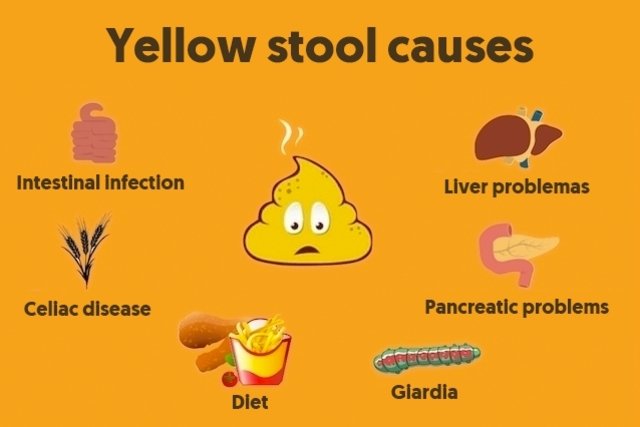 The red color of feces is more common in cancerous tumors of the intestine, since they ulcerate faster and disintegrate with the involvement of blood vessels in the process. Disturbed by dull pains in the abdominal cavity, prolonged constipation, progressive weight loss.
The red color of feces is more common in cancerous tumors of the intestine, since they ulcerate faster and disintegrate with the involvement of blood vessels in the process. Disturbed by dull pains in the abdominal cavity, prolonged constipation, progressive weight loss.
Complications of pharmacotherapy
Stool staining is most common with long-term treatment with the anti-tuberculosis drug rifampicin. It has a red color and, when ingested, turns into metabolites, which are excreted in different ways. Therefore, not only feces acquire a reddish color, but also urine, lacrimal fluid, and sweat. Atypical staining of feces is sometimes possible with long-term use of high doses of vitamin A, which contains carotene pigments.
Diagnostics
If red stool is combined with complaints of pain and dysfunction of the gastrointestinal tract, the patient should consult a gastroenterologist. Diagnostic search involves a comprehensive examination of the digestive system using laboratory and instrumental methods.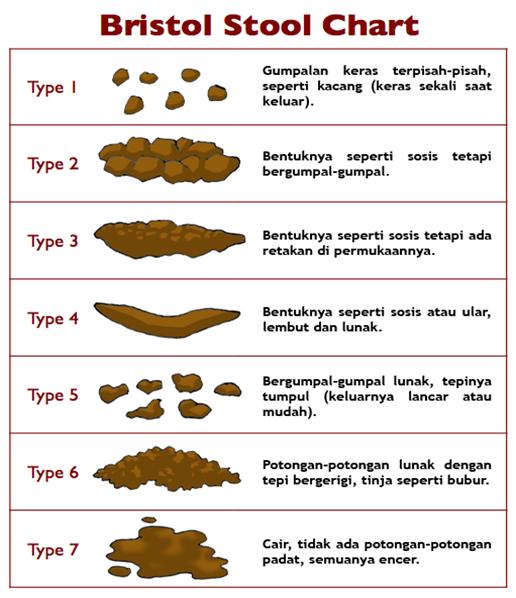 The most informative are:
The most informative are:
- Coprogram . To confirm the presence of blood in the feces, the Gregersen reaction is necessary. Microscopic analysis assesses the amount of undigested food, the presence of leukocytes. If infectious causes of red stools are suspected, bacteriological culture of feces on nutrient media is recommended. To diagnose UC, determine the level of fecal calprotectin.
- Endoscopy . Endoscopic examination has the greatest diagnostic value in organic diseases of the lower gastrointestinal tract. To study the state of the distal colon, it is enough to prescribe sigmoidoscopy and sigmoidoscopy. Colonoscopy allows you to view the entire large intestine. During the procedure, a biopsy is taken from suspicious areas.
- X-ray method . For the purpose of a comprehensive assessment of the state of the digestive tract, radiography of the passage of barium is shown, with the help of which destructive changes in the intestine, neoplasia are revealed.
 If it is impossible to perform a colonoscopy, irrigography with double contrast is used to diagnose the pathology of the colon.
If it is impossible to perform a colonoscopy, irrigography with double contrast is used to diagnose the pathology of the colon. - Laboratory tests . In the general blood test, there are signs of anemia, the severity of which correlates with the degree of blood loss. To confirm the inflammatory cause of the appearance of red feces, a biochemical analysis and an extended immunogram are used. It is possible to establish bacterial infections in which the intestine is affected by the detection of specific antibodies in plasma.
Treatment
Help before diagnosis
Discharge of atypically colored feces, which is caused by excessive consumption of red foods and proceeds against the background of good health, does not require therapeutic measures. If the symptom is observed simultaneously with abdominal pain, nausea and vomiting, you need to see a doctor to find out why the red stool appeared. Intestinal bleeding requires emergency medical attention.
Conservative therapy
Medical tactics depend on the cause of red coloration of the feces. In intestinal infections, along with medications, therapeutic fasting or a sparing diet with strict restrictions is indicated; oral rehydration is recommended to correct water-salt metabolism. The purpose of drugs is aimed at eliminating the underlying pathology that caused red feces. Most commonly used:
- Antibiotics . Drugs are selected that selectively affect the bacteria of the intestinal group. For the best effect, they are combined with local antibacterial agents that act only in the intestinal lumen. In amebiasis, specific antiprotozoal drugs are indicated.
- Anesthetics . With hemorrhoids, anal fissure, pain syndrome comes to the fore, for the relief of which suppositories and ointments with local anesthetics are used. The drugs improve the well-being of patients and create conditions for the rapid healing of mucosal defects.

- Derivatives of 5-aminosalicylic acid. These drugs are essential for the treatment of UC and Crohn’s disease. They have a pronounced anti-inflammatory effect, stimulate the regeneration of the epithelium and the healing of intestinal ulcers. In severe forms, immunosuppressants are added to the therapy regimen.
- Plasma substitute solutions . Infusion therapy is carried out with massive intestinal bleeding to restore BCC and maintain heart function. Infused solutions contain optimal concentrations of basic electrolytes. Colloidal preparations, fresh frozen plasma are also administered.
Surgical treatment
In case of hemorrhoids, such types of surgical interventions as ligation of nodes with elastic rings, sclerotherapy, radical removal of the main internal nodes are widely used. In severe recurrent inflammatory diseases of the colon, removal of the affected part of the intestine with the formation of an anastomosis is indicated to prevent bleeding and perforation. For colon cancer, a hemicolectomy or total colectomy is performed.
For colon cancer, a hemicolectomy or total colectomy is performed.
What affects the color of excrement?
The color of the stool may be the result of eating a certain food or may indicate an existing health problem.
So why can feces change color? What color should be a cause for concern, and what just depends on the food consumed?
- Beets
Red beets contain the enzyme betacyanin, which is responsible for the blood-like color. During the digestion of food, most substances are broken down to such an extent that they lose their color. Betacyanin is processed differently in different people. And if you really consumed beets in the last few days, then with a high probability the red color of the feces is precisely because of the beets. If you notice red spots in your stool but haven’t eaten beets or any of the other red foods on this list, it could be blood. In this case, it is recommended to immediately consult a doctor.
- Green vegetables
If you eat a lot of greens, in particular spinach, broccoli, lettuce, this can be reflected in the color of your excrement. Foods with a lot of green pigment can cause stool to turn green. If you are not experiencing any other symptoms and feel healthy, green stools are a sign that you have been eating green vegetables.
Foods with a lot of green pigment can cause stool to turn green. If you are not experiencing any other symptoms and feel healthy, green stools are a sign that you have been eating green vegetables.
- Blueberry
Don’t be surprised if you see black or blue stools. If after some period after eating blueberries your feces are stained, then there is no reason for concern. However, bluish-purple stools are also a symptom of a rare disease called porphyria. Other symptoms of porphyria include nausea, breathing problems, and seizures.
- Food coloring
Food coloring found in some foods can also affect the color of stool. Therefore, try to remember if you accidentally ate products of a similar color.
- Medications
Some medications may affect the color of stool. So, for example, medicines for diarrhea, heartburn, nausea can stain saliva and feces black.

 If it is impossible to perform a colonoscopy, irrigography with double contrast is used to diagnose the pathology of the colon.
If it is impossible to perform a colonoscopy, irrigography with double contrast is used to diagnose the pathology of the colon.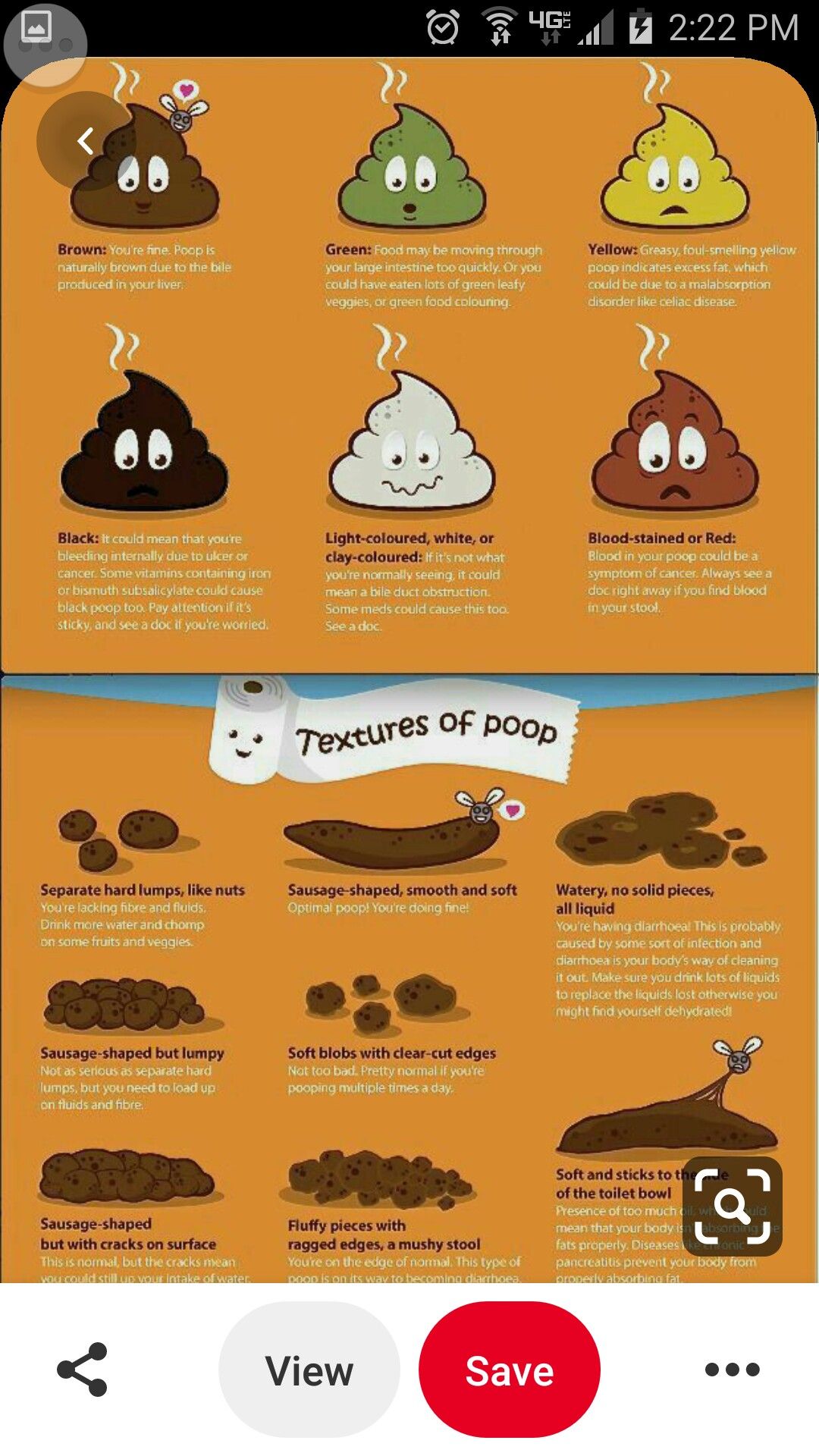
 Foods with a lot of green pigment can cause stool to turn green. If you are not experiencing any other symptoms and feel healthy, green stools are a sign that you have been eating green vegetables.
Foods with a lot of green pigment can cause stool to turn green. If you are not experiencing any other symptoms and feel healthy, green stools are a sign that you have been eating green vegetables.